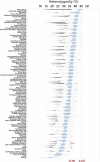Genetic prevalence and clinical relevance of canine Mendelian disease variants in over one million dogs
- PMID: 36848397
- PMCID: PMC9997962
- DOI: 10.1371/journal.pgen.1010651
Genetic prevalence and clinical relevance of canine Mendelian disease variants in over one million dogs
Abstract
Hundreds of genetic variants implicated in Mendelian disease have been characterized in dogs and commercial screening is being offered for most of them worldwide. There is typically limited information available regarding the broader population frequency of variants and uncertainty regarding their functional and clinical impact in ancestry backgrounds beyond the discovery breed. Genetic panel screening of disease-associated variants, commercially offered directly to the consumer or via a veterinary clinician, provides an opportunity to establish large-scale cohorts with phenotype data available to address open questions related to variant prevalence and relevance. We screened the largest canine cohort examined in a single study to date (1,054,293 representative dogs from our existing cohort of 3.5 million; a total of 811,628 mixed breed dogs and 242,665 purebreds from more than 150 countries) to examine the prevalence and distribution of a total of 250 genetic disease-associated variants in the general population. Electronic medical records from veterinary clinics were available for 43.5% of the genotyped dogs, enabling the clinical impact of variants to be investigated. We provide detailed frequencies for all tested variants across breeds and find that 57% of dogs carry at least one copy of a studied Mendelian disease-associated variant. Focusing on a subset of variants, we provide evidence of full penetrance for 10 variants, and plausible evidence for clinical significance of 22 variants, on diverse breed backgrounds. Specifically, we report that inherited hypocatalasia is a notable oral health condition, confirm that factor VII deficiency presents as subclinical bleeding propensity and verify two genetic causes of reduced leg length. We further assess genome-wide heterozygosity levels in over 100 breeds, and show that a reduction in genome-wide heterozygosity is associated with an increased Mendelian disease variant load. The accumulated knowledge represents a resource to guide discussions on genetic test relevance by breed.
Copyright: © 2023 Donner et al. This is an open access article distributed under the terms of the Creative Commons Attribution License, which permits unrestricted use, distribution, and reproduction in any medium, provided the original author and source are credited.
Conflict of interest statement
I have read the journal’s policy and the authors of this manuscript have the following competing interests: All authors are employees of Wisdom Panel, Kinship, that offers canine genetic testing as a commercial service.
Figures




References
-
- Online Mendelian Inheritance in Animals, OMIA. Sydney School of Veterinary Science. Available from: https://omia.org/.
-
- Donner J, Kaukonen M, Anderson H, Möller F, Kyöstilä K, Sankari S, et al.. Genetic panel screening of nearly 100 mutations reveals new insights into the breed distribution of risk variants for canine hereditary disorders. PLoS One. 2016;11(8):e0161005. doi: 10.1371/journal.pone.0161005 - DOI - PMC - PubMed
-
- International Partnership for Dogs, IPFD. Harmonization of Genetic Testing In Dogs—Quality Testing Database. Available from: https://dogwellnet.com/ctp/.
MeSH terms
Associated data
LinkOut - more resources
Full Text Sources
Other Literature Sources
Medical

